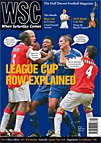 Clubs’ own sites are often seen as being dull, uniform, run by the game’s Thought Police – but as we all know that, does it matter too much? Ian Plenderleith had a look inside a few to find out
Clubs’ own sites are often seen as being dull, uniform, run by the game’s Thought Police – but as we all know that, does it matter too much? Ian Plenderleith had a look inside a few to find out
In the interests of balance and fairness, it’s time this column moved away from its usual celebration of plucky, left-field, independent sites devoted to lesser leagues, earnest groundhoppers, obscure photographers and mouldy mascots, and ventured into an area it has been ignoring for far too long. This month we delve into a world rarely explored by the conscientious WSC reader: the official club websites of the world famous English Premier League.
It’s a filthy job, but someone has to do it. Just over two years ago, in reviewing a management consultant’s report that criticised club sites for failing to squeeze more cash out of fans through their websites (WSC 216), I wrote that you’d “have to pay me handsomely to get me on a Premiership team’s official site”. But of course I am paid handsomely, so that excuse holds no water, and the time has come to sweep aside my own prejudices about what I might find there.
Just for the record, before we go there, my prejudices about Premier League official sites are that they’re probably dominated by the following: banal content; selective history; a cumbersome registration process; and ads for overpriced, team-related crap you don’t need.
First, though, it’s worth quoting a report in the digital-business trade magazine Revolution, which undertook a comprehensive look at all the clubs’ sites by contracting various web design, content and traffic experts to assess which ones ranked the best. Its report, a summary of which is available online, found that – despite a decade or more in which to get their websites right – many clubs apparently still fail to understand what internet users want.
Team sites are handicapped by simply remedied factors such as generic layout (half the teams’ sites look the same, as they are run through one company, Premium TV), slow downloads, an abundance of third-party ads and the denial of access to casual browsers who haven’t registered. The magazine’s top-rated site, however, was Manchester United’s, citing that club’s redesign (“providing seamless integration for Manchester United’s sponsors and affiliated partners”, according to its designer) as the major reason for its success.
The magazine quoted one expert, Marty Carroll, who also holds the world record for the longest job title with the post “director of consultancy at usability and web analytics company Foviance”, as saying: “Consistency is a hallmark of this site. It behaves in the way a visitor would expect with no surprises. It is a very comprehensive offering.”
So, unprepared for surprises, I was surprised to find that I spent a long time on the official Manchester United site, but in much the same way you might look around Buckingham Palace. You’re curious to have a look and explore a few corridors, but you probably wouldn’t want to live there, or even hang around, because everything (apart from the excellent stats site, which seems to be a separate entity) is designed to tell you what a huge and grand club they are and that you should feel privileged to be allowed to look inside the theatre of dreams, the hall of legends, the chamber of silverware etc. But don’t touch anything unless you’re going to buy a ringtone, the third away shirt and a subscription to MUTV.
If this admittedly expansive, though hardly indispensable, offering finished top of Revolution’s league table, where did that leave the rest? I went straight down to the bottom end of the table, where Bolton Wanderers had been ranked equal last with Wigan.
No doubt this is an unscientific and inexpert assessment, but the Bolton site, which is one of the PTV-run sites criticised by the magazine, was a much quicker, easier surfing experience. I could use my Lincoln City (also a PTV site) user name and password to enter and access content, and my familiarity with Lincoln’s standard site meant that I knew where to find everything at Bolton’s.
By contrast, United’s had opened up new browser windows and so many possibilities that it was almost too overwhelming. Carroll’s view that fans going to an official site want no surprises is probably correct, but he seems to have a skewed idea of what constitutes a surprise. At Bolton, you get the news, the match report and the bread and butter interview with Sam Allardyce (“the defining issue tomorrow will be who has their sharp-shooting boots on”). It’s neither the megastore nor the Stalinesque deification you get at The Old Trafford Online Mansion of Hallowed Tradition.
Even if some of my prejudices about official sites were confirmed, at least I realised I was comfortable with those preconceived notions. I’ve always been the kind to buy the official match magazine and the fanzine too, because both can inform, exasperate and amuse you in their own different ways. In that sense, club sites should no more be subject to analysis by fancy-titled consultants than the match programme should be deconstructed by the Times Literary Supplement.
In fact, a good old rubbish official team site is like your team’s battle-hardened defensive midfielder. You don’t much like his style, but you’re glad he’s there.
From WSC 242 April 2007. What was happening this month